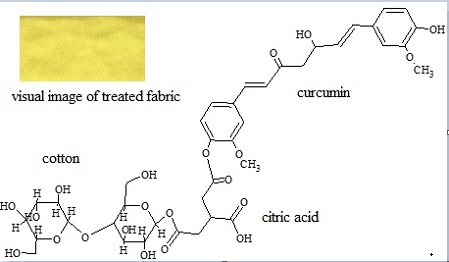Dyeing of curcumin and durable press finishing with citric acid on cotton fabric using one step process
DOI:
https://doi.org/10.55713/jmmm.v32i4.1548คำสำคัญ:
citric acid, cotton, curcumin, durable press finishing, one step processบทคัดย่อ
Cotton is an affordable and durable option for clothing. However, cotton garments tend to wrinkle easily. Therefore, cotton fabrics were studied to improve their wrinkle resistance properties. In this work, curcumin was mixed in an aqueous solution of citric acid and its catalyst and applied to cotton fabric using pad-dry-cure process for both the dyeing and finishing properties. Aloe vera extract and chitosan were used to compare for the reaction of their functional groups with carboxyl groups of citric acid on cotton fabrics. The mixture of curcumin and citric acid solution showed anti-wrinkle properties on the treated cotton. There were no functional groups of curcumin detected on the FTIR spectrum of the fabric. Furthermore, acetyl group of chitosan and methyl in acetyl group of aloe vera extract were found on the spectra of the fabrics treated with each compound. It was also found that the treated fabric showed good UV protection properties and good antibacterial gram-positive properties. This fabric has physical potential to be used for healthcare, hygiene and medical textile products.
Downloads
เอกสารอ้างอิง
S. Islam, S. Ahmed, M. Arifuzzaman, A. S. Islam, and S. Akter, “Relationship in between strength and polyester content percentage of cotton polyester blended woven fabrics,” International Journal of Clothing Science, vol.6, pp. 1-6, 2019.
C. W. M. Yuen, C. W. Kan, and H. L. Lee, “Improving wrinkle resistance of cotton fabric by montmorillonite,”. Fibers and Polymers, vol. 7, pp. 139-145, 2006.
Y. Can, M. Akaydin, Y. Turhan, and E. Ay, “Effect of wrinkle resistance finish on cotton fabric properties,” Indian Journal of Fibre & Textile Research, vol. 34, pp. 183-186, 2009.
V. A. Dehabadi, H. J. Buschmann, and J. S. Gutmann. “Durable press finishing of cotton fabrics: an overview,” Textile Research Journal, vol. 83, pp. 1974-1995, 2013.
H. Wang, C. Zhang, X. Chu, and P. Zhu. “Mechanism of antiwrinkle finishing of cotton fabrics using mixed polycarboxylic acids,” International Journal of Polymer Science, vol. 2020, pp. 1-10, 2020.
N. Muthukumar, and G. Thilagavathi. “Crease resistance finishing of cotton fabrics using citric acid,” Asian Dyer, vol. 16, pp. 46-49, 2019.
X. Luo, P. Cheng, W. Wang, J. Fu, and W. Gao. “Established an eco-friendly cotton fabric treating process with enhancing anti-wrinkle performance,” Journal of Engineered Fibers and Fabrics, vol. 16, pp. 1-11, 2021.
M. I. H. Mondal, and J. Saha. “Antimicrobial, UV resistant and thermal comfort properties of chitosan- and aloe vera-modified cotton woven fabric,” Journal of Polymers and the Environment, vol. 27, pp. 405-420, 2019.
P. Anand, A. B. Kunnumakkara, R. A. Newman, and B. B. Aggarwal. “Bioavailability of curcumin: problems and promises,” Molecular Pharmaceutics, vol. 4, pp. 807-818, 2007.
X. Cui, T. Honda, T. A. Asoh, and H. Uyama. “Cellulose modified by citric acid reinforced polypropylene resin as fillers,” Carbohydrate Polymers, vol. 230, pp. 1-7, 2020.
J. F. Pereira, B. M. Marim, and S. Mali. “Chemical modification of cellulose using a green route by reactive extrusion with citric and succinic acids,” Polysaccharides, vol. 3, pp. 292-305, 2022.
G. Dhiman, and J.N. Chakraborty. “Assessment of durable press performance of cotton finished with modified DMDHEU and citric acid,” Fashion and Textiles, vol. 4, pp. 1-18, 2017.
M. Ahmed, N. Sukumar, and R. K. Gideon. “Crease resistance finishing optimization of citric acid and fibroin solution for cotton fabrics,” Journal of Natural Fibers, vol. 18, pp. 297-307, 2021.
S. Kursun, and G. Ozcan. “An investigation of UV protection of swimwear fabrics,” Textile Research Journal. vol. 80, pp. 1811-1818, 2010.
R. M. Epand, C. Walker, R. F. Epand, and N. A. Magarvey. “Molecular mechanisms of membrane targeting antibiotics,” Biochimica et Biophysica Acta, vol. 1858, pp. 980-987, 2016.
S. Y. Teow, K. Liew, S. A. Ali, A. S. Khoo, and S. C. Peh. “Antibacterial action of curcumin against Staphylococcus aureus: a brief review,” Journal of Tropical Medicine, vol. 2016, pp. 1-10, 2016.
J. Wang, X. Zhou, W. Li, X. Deng, Y. Deng, and X. Niu. “Curcumin protects mice from Staphylococcus aureus pneumonia by interfering with the self-assembly process of α-hemolysin,” Scientific Reports, vol. 6, pp. 1-12, 2016.
T. Li, Y. Zhao, K. Matthews, J. Gao, J. Hao, S. Wang, J. Han, and Y. Jia. “Antibacterial activity against Staphylococcus aureus of curcumin-loaded chitosan spray coupled with photodynamic treatment,” Lebensmittel-Wissenschaft und-Technologie, vol. 134, pp. 1-7, 2020.
S. Y. C. Tong, J. S. Davis, E. Eichenberger, T. L. Holland, and V. G. Fowler Jr. “Staphylococcus aureus infections: epidemiology, pathophysiology, clinical manifestations, and management,” Clinical Microbiology Reviews, vol. 28, pp. 603-661, 2015.
N. Ahmad-Mansour, P. Loubet, C. Pouget, C. Dunyach-Remy, A. Sotto, J. P. Lavigne, and V. Molle. “Staphylococcus aureus toxins: an update on their pathogenic properties and potential treatments,” Toxins, vol. 13, pp. 1-22, 2021.
P. Tyagi, M. Singh, H, Kumari, A. Kumari, and K. Mukhopadhyay. “Bactericidal activity of curcumin I is associated with damaging of bacterial membrane,” PLoS One, vol. 10, pp. 1-15, 2015.
H. Abdulrahman, L. Misba, S. Ahmad, and A. U. Khan. “Curcumin induced photodynamic therapy mediated suppression of quorum sensing pathway of Pseudomonas aeruginosa: An approach to inhibit biofilm in vitro,” Photodiagnosis and Photodynamic Therapy, vol. 30, pp. 1-7, 2020.

ดาวน์โหลด
เผยแพร่แล้ว
วิธีการอ้างอิง
ฉบับ
บท
การอนุญาต
ลิขสิทธิ์ (c) 2022 วารสารโลหะ, วัสดุ และแร่

This work is licensed under a Creative Commons Attribution-NonCommercial-NoDerivatives 4.0 International License.
Authors who publish in this journal agree to the following terms:
- Authors retain copyright and grant the journal right of first publication with the work simultaneously licensed under a Creative Commons Attribution License that allows others to share the work with an acknowledgment of the work's authorship and initial publication in this journal.
- Authors are able to enter into separate, additional contractual arrangements for the non-exclusive distribution of the journal's published version of the work (e.g., post it to an institutional repository or publish it in a book), with an acknowledgment of its initial publication in this journal.












